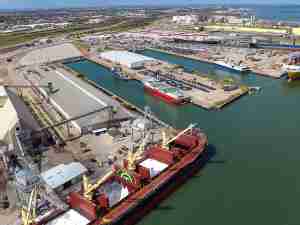Fitch Affirms Hawaii DOT’s $309 Million Harbor System Revs At ‘A+’; Outlook Revised to Positive
posted by AJOT | Feb 17 2017 at 07:50 AM | Ports & Terminals
Fitch Ratings has affirmed the 'A+' rating on the Hawaii Department of Transportation's (HI) $309 million in outstanding harbor system revenue bonds. The Rating Outlook has been revised to Positive from Stable.
The Positive Outlook reflects the increased likelihood that the harbor system will be able to sustain its continued strong financial performance in terms of coverage, liquidity, and leverage based on positive operational activities and enacted tariff adjustments even with additional borrowings anticipated under its multi-year capital program. Recent coverage levels have been above 3x while leverage has been trending downward to below 1.0x.
KEY RATING DRIVERS
Summary: The 'A+' rating reflects the harbor system's natural monopoly position serving the islands of Hawaii. The system benefits from strong volume growth since 2011 along with approved multi-year tariff rate increases that provide revenue stability. Despite a sizeable capital plan that calls for additional borrowing, the harbor system is expected to maintain its historically robust financial profile with relatively strong coverage, relatively low leverage, and high liquidity providing over 1,000 days cash on hand (DCOH).
Stable Volume Supported by Natural Monopoly: Revenue Risk: Volume - Stronger
Port volumes are rising and are also anchored by the essentiality of the port to the state's economy. The port system provides essential maritime services and serves a state without an efficient alternative means of transporting goods to and throughout it. This partially mitigates the system's exposure to fluctuations in the tourism industry.
Scheduled Tariff Increases: Revenue Risk: Price - Midrange
The harbor system has a history of adopted scheduled tariff increases for cruise, cargo, and pipelines. Recent increases included a mechanism to increase cargo tariffs annually by the greater of 3% or CPI from 2015 onwards. Greater escalations were implemented in fiscal year (FY) 2017 (17% increase in cargo tariffs) and continue through 2019 (15 % in cargo tariffs). No material elasticity to port demand has been seen through these tariff adjustments historically.
Considerable Capital Plan: Infrastructure Development/Renewal - Midrange
The current five-year capital improvements program (CIP), currently sized at $568 million, focuses largely on the Harbors Modernization Plan and consists of various projects to enhance the system's efficiency and capacity by addressing long-term capital needs. It is expected that the plan will necessitate additional leverage, with $250 million in revenue bonds expected in early calendar year 2018.
Conservative Debt Structure: Debt Structure - Stronger
The harbor system has relatively low leverage consisting of all fixed rate bonds with a rapid amortization schedule on existing debt, somewhat mitigating the limited protection provided by the 1.25x rate covenant and additional bonds test (1.0x excluding contingency account and other allowable funds).
Strong Financial Profile: The harbor system benefits from stable operating margins with a sizable liquidity cushion of 1,780 DCOH in 2016. While balances may vary with spending for the CIP, management targets maintaining at least 1,000 days cash. Coverage has been relatively strong at over 2.0x historically (3.16x in FY 2016) and is expected to remain at these levels through the forecast period. Leverage is low at 1.4x for rated debt, and is expected to remain in the 2x to 4x range in the next five years when incorporating additional borrowing for the CIP.
PEER GROUP
San Diego Unified Port District (rated 'A+'/Stable Outlook) serves as a comparable peer to the harbor system. The district has a strong senior lien debt service coverage ratio (DSCR) of 9.35x and low total leverage of -1.30x. The harbor system compares favorably in terms of its metrics and strong demand for port services, with a DSCR of 3.16x and low leverage of 0.8x. The peer shares solid demand and utilization of its port system, along with consistency of favorable metrics on senior obligations.
RATING SENSITIVITIES
Positive - The ability to maintain strong coverage levels averaging over 2.5x as well as low leverage below 4.0x net debt to cash flow available for debt service (CFADS), taking into account anticipated borrowings for the capital program, could result in a higher rating.
Negative - Cargo Volatility: Increased volatility in throughput volumes that result in coverage sustained at or below 2.0x could pressure the rating.
Negative - Additional Debt Eroding Cash Flow: Credit quality may be adversely affected if leverage increases to and is maintained above 5.0x net debt to CFADS.
Performance Update
Overall cargo volumes (measured in short tons) continued to increase in FY 2016 by 2.1% with 21.3 million tons of cargo moving through the Hawaii ports. The system's cargo volumes have rebounded to pre-recession levels, growing at a five-year compound annual growth rate (CAGR) of 2.4%, after significant declines in 2009 and 2010. The throughput recovery that began in 2011 reflects rebounding tourism activity. Fitch expects continued volume stability at the harbor system given its natural monopoly as the sole transporter of goods to the island state, effectively mitigating the port's risk to fluctuations in tourism.
FY 2016 revenues for cargo shipped through the harbor system increased 7.3%, reflecting the harbor system's second year of tariff increases at the greater of 3% or CPI. While the recession caused declines in operating revenues during the 2008 - 2010 period, multi-year tariff increases starting in 2010 have led to a healthy rebound in operating revenues. The harbor system has implemented annual tariff rate increases of 17%, 15%, and 15% from FY 2017 through FY 2019 for cargo and pipeline tariffs. Likewise, passenger fees have increased $0.50 annually since 2011, and were increased to $7.50 in FY 2017. These prescribed increases will provide considerable revenue flexibility and cash flow stability to the harbor division, and are intended to support the division's sizable modernization plan. The port system anticipates issuing $250 million in additional debt in early FY 2018 as part of this program.
Operating expenses increased 3.3% in FY 2016 primarily due to increases in maintenance costs and personnel services costs, but remained below budget by 15.4%. Going forward, Fitch expects more normalized increases in the system's operating expense profile as harbor operations return to pre-recession levels and labor costs covered under collective bargaining agreements drive future operating costs.
The harbor division has historically recorded strong cash levels and healthy debt service coverage ratios. The system has strong liquidity with more than 1,750 days cash on hand in FY 2016, and management intends to maintain 1,000 DCOH going forward, which is supportive to the current rating level. Fitch believes cash balances will remain solid, although they may decline some as management executes the harbor modernization plan over the next several years. The system had low leverage at a Fitch-estimated 0.8x in FY 2016, though this will likely rise to 2x to 3x with the additional borrowing in FY 2018.
Debt service coverage in FY 2016 was robust at 3.16x and higher than Fitch's prior year base case forecast of 2.66x. The stronger DSCR in comparison to expectations is attributed to the partial tariff rate increase of 3% in FY 2016, which was previously scheduled to be a part of FY 2017's annual tariff rate increase. When including the system's general obligation payment requirements of approximately $3.3 million per year for obligations related to the Superferry project, all-in coverage is slightly lower but still remains strong at 2.86x.
Fitch Cases
Fitch's base case reflects the harbor system's forecast through 2020 which includes scheduled tariff increases. Thereafter, revenues experience moderate growth of 3% per year and expenses grow at 3.5% per year. Under this scenario, total operating revenues net of tariff increases average 1.6% growth through 2022. DSCRs average 3.15x, with a minimum of 2.90x in FY 2017.
Fitch's rating case considers a scenario of combined throughput reduction resulting in greater sustained revenue stress through 2019 and increases in operating expenses throughout the forecast period. Total operating revenues net of tariff increases averages -1.7% through 2022. Under this scenario, DSCRs average 2.32x with a minimum of 1.98x in 2017.
Both scenarios consider the harbor system's anticipated additional borrowing of $250 million in calendar year 2018. Leverage levels are expected to initially increase from currently moderate to around 2.8x in FY 2018 under Fitch's rating case, but should fall to 1.9x by 2022.
Asset Summary
The State of Hawaii Department of Transportation harbors division consists of 10 commercial harbors on six islands, with Honolulu serving as the state's principal port and trans-shipment station for cargo that is bound for the other islands. As a monopoly, the harbor system benefits from the lack of alternative means of transporting cargo to and throughout the state, as well as the state's limited commodity and manufacturing base, which results in an inelastic demand for imported goods.
The revenue bonds are special limited obligations of the State of Hawaii, payable from and secured solely by net revenue generated by the harbor system.










